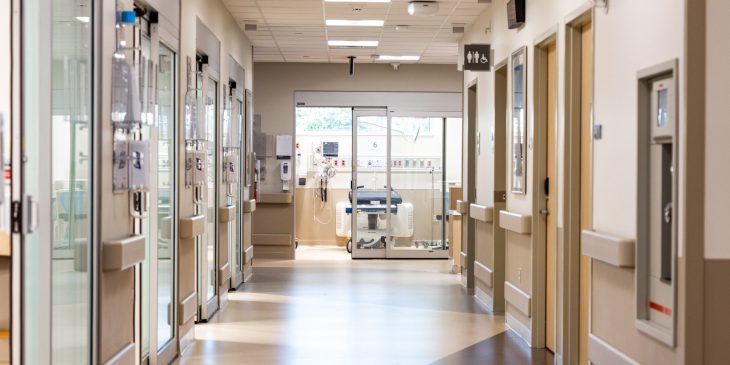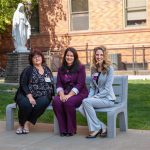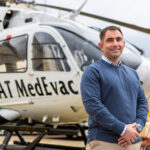Across UPMC, we provide high quality care in a variety of different settings: hospitals, outpatient centers, primary care offices, urgent care locations, and more. As our fellow community members enter through our various front doors seeking our expertise on their health care journeys, we strive to provide the same welcoming experience for them, regardless of location.
As we know from our seven years honing our key behaviors as part of the UPMC Experience, when we’re at work, we own and care for the space as if it were our own home. Part of doing this includes making sure our guests feel valued, respected, and cared for. Just one of the many areas where we focus our attention on this is in each of our Emergency Departments.
“Most people we serve in a hospital across the UPMC network begin their journeys in the EDs, said Donald M. Yealy, MD, chief medical officer and senior vice president, Health Services Division. “During this important time — often the height of a patient’s needs and the start of their care journey with us — we focus on doing things that improve the perception of care from the minute patients step through our doors.”
Innovating While Perfecting How Care is Provided to Meet the Needs of Each Community
UPMC provides top-quality emergency care in all of its EDs. Across UPMC’s footprint, we have a diverse mix of academic hospitals in urban cities, specialty hospitals across the regions, and community hospitals in rural and suburban settings.
While our emergency medical care is consistently high-level and compassionate, the care models for this specialty look different depending on which location or community a patient finds themselves in. In addition to focusing on implementing tactics to refine how care is provided to every patient, every day, UPMC is innovating emergency care to meet each of our patients’ needs.
In recent years, this detailed focus on tailoring how emergency care is provided to improve patient flow and positive outcomes and experiences is evidenced through the innovation of our different emergency care facilities systemwide.
Redefining Rural Emergency Health Care
In response to a need for increased emergency care and a reimagined hospital design and function in a rural community, the facility formerly known UPMC Lock Haven became the UPMC Outpatient Emergency Department (OED) in Lock Haven in 2023.
On April 4, the UPMC OED in Lock Haven celebrated its first anniversary, solidifying its status as Pennsylvania’s only OED after adopting and embracing the innovative care model sanctioned by the Department of Health. This milestone emphasized the OED’s pivotal role in redefining rural emergency health care.
This transformation has enabled UPMC to uphold its mission of providing accessible, high quality, and efficient health care.
“The OED has strengthened the existing partnerships with local emergency medicine services (EMS), as they help facilitate the transfer of approximately 100 patients per month to UPMC Williamsport and UPMC Muncy, in addition to other specialty health care resources when appropriate,” said Ron Reynolds, president, UPMC facilities in Lock Haven and UPMC Muncy. “We took advantage of the innovative model of care, and we are proud that it is working magnificently — it’s firing on all cylinders.”
Patients are taking note of the OED’s achievement of positive results as well. Prior to the transition, patient satisfaction scores were in the 40s on a scale of 0-100. Currently, they have risen to the mid-70s. This upward trajectory is anticipated to continue, and a bright future of enhanced health care is expected for the Lock Haven community.
Improving Health Access by Connecting Emergency and Primary Care
When health care needs arise in our communities, UPMC prioritizes its resources and responds. That’s why UPMC Jameson and UPMC Horizon leaders are thinking outside of the box by creating a new process for all “unassigned” patients, those who do not have an established primary care physician (PCP), who are discharged from UPMC EDs in Farrell, Greenville, and New Castle.
UPMC Horizon and UPMC Jameson are leveraging and expanding the Mercer County-based UPMC Horizon Family Medicine Residency Program into neighboring Lawrence County to improve health outcomes and continuity of care for patients in that community.
When ED patients do not have an established PCP for after-emergency care coordination, it can create barriers in the next steps of the care plan, impede their treatment and recovery, and lead to hospital readmission and worsening of their condition. A PCP coordinates specialty services, diagnostics, and holistic care for the patient.
“We believe that ‘health is primary.’ There is a direct linkage between health and primary care, and that starts with a personal physician.” Martin Johns, MD, program director, UPMC Horizon Family Medicine Residency. “We give the patient an appointment date and time with a local family medicine resident, who will be their new PCP, before they leave our care. From that point forward, the family medicine resident serves as a central, essential point of contact for the patient’s health and care coordination.”
Family medicine residents are physicians who are completing their training as primary care specialists who provide comprehensive health care for people of all ages. They are trained to treat a wide range of medical conditions, providing preventive care, chronic disease management, and health education.
Over the last five years, thousands of patients in Mercer County have gained a PCP through this innovative approach. This year, a new clinic was added in New Castle, expanding the program into Lawrence County and increasing the total number of residents from 12 to 18.
Dr. Johns continued, “By growing our program, caring for more people in the community, we are increasing access to care and improving the health of our population.”
UPMC Horizon-Shenango Valley recently expanded its ED further increasing access to needed care for the community.
Expanding to Care for More Patients
Focusing now on a more suburban community that UPMC serves, tailored emergency services are delivered in Monroeville at UPMC East. After recognizing the greater need for increased access and additional space for this care in that community, the Emergency Department underwent a 16-month construction project to expand. The additional space increased capacity by 50%, adding 30,000-square feet, increasing the number of private exam rooms from 24 to 44, and expanded space for clinical engineering, information technology, and central sterile processing. It also provided space for an outpatient retail pharmacy.
The $24 million expansion was necessary to allow staff to care for more patients, reduce wait times, and provided added expert care to the Monroeville community and surrounding areas.
A Unique Collaboration Allowing Patients to Stay Close to Home
To increase patient access to a rural community, in 2022 UPMC launched the first tele-Emergency Department (tele-ED) in Pennsylvania at UPMC Kane located rural McKean County. The service has allowed expanded access to more advanced care enabling patients to stay close to home in their community hospital.
UPMC Kane partners with UPMC Hamot in Erie to create an emergency medicine collaboration using advanced telemedicine technology. Board-certified emergency medicine physicians located at UPMC Hamot, 94 miles away, partner with on-site, trained advanced practice providers (APPs) at UPMC Kane, 24 hours a day, seven days a week.
“Bedside care is delivered by physician assistants (PAs) and certified registered nurse practitioners (CRNPs) using advanced video, audio, and examination technology to immediately and seamlessly connect patients with board certified emergency medicine physicians at UPMC Hamot,” said Mark Papalia, president, UPMC Kane. “Together, the APP and physician diagnose and care for the patient.”
Bringing Advanced Pediatric Care to a Growing Community
While UPMC has a strong footprint in the North Hills suburbs of Pittsburgh, access to its specialty children’s services was still a greater need for that region. To help eliminate the need for families to travel to Lawrenceville for pediatric emergency services, both UPMC Passavant campuses in McCandless and Cranberry Township became the first hospitals in western Pennsylvania in 2021 to expand these services with virtual tele-communication consultations with UPMC Children’s Hospital of Pittsburgh.
The technology allows UPMC Passavant providers to work with pediatric emergency medicine physicians at UPMC Children’s via real-time virtual telemedicine consultations — around the clock. This collaborative approach allows a higher level of pediatric emergency care through advanced telemedicine technology in the continually growing North Hills community.
The new affiliation also allows pediatric patients to connect seamlessly with UPMC Children’s 400+ physicians across 33 subspecialities for follow-up appointments. These appointments can be scheduled
“Creating an exceptional patient experience with access to UPMC’s advanced, signature specialty care is always our top priority,” said Susan Hoolahan, president, UPMC Passavant. “The program harnesses the world-class expertise, unique resources, and advanced technology that only UPMC can provide.”
Introducing the UPMC ED Experience Collaborative
Though different, each of these emergency services models ultimately delivers a more customized approach to better meet the needs of the people and communities we serve. UPMC’s commitment to people-focused health remains evident across all our services and regions. As we continue growing and improving our UPMC Experience, we are adding a focus on our Emergency Departments specifically, to make sure all who enter through them start their care journey with us off on the right foot.
UPMC launched the ED Experience Collaborative at the start of 2024 to focus on strategies and tactics ED teams across the system can implement to improve the daily flow of care for all patients. A branch underneath the UPMC Experience umbrella, the ED Experience Collaborative meets four times this year and is a targeted learning opportunity for all ED clinicians, physicians, and leaders across UPMC.
“Being technically excellent is expected, and we do that exceptionally well. But, making sure our patients, all the time, experience the caring that’s involved in health care — the human interaction and timeliness — is important,” said Dr. Yealy. “This doesn’t mean we’re changing the medicine within ED care, but it does mean that we’re focusing on how we deliver an experience for all patients that we’d want for our family and loved ones.”
The ED Experience Collaborative educates on specific tactics to help our ED teams provide this finer touch on the care they’re giving, garner more positive patient feedback, and nurture better cross-team collaboration. This includes improving communication with patients and fellow employees through proven frameworks like AIDET Plus the Promise, communication boards, and waiting room rounding. Developing strong relationships with teams that work closely with the ED, such as Lab Services and Imaging, by using an ED strategic stakeholder meeting, is also a key focus to help improve patient flow and perception of care.
“This is not a fad that’s here for a period of time,” said Dr. Yealy. “This is a durable focus and change.”
The ED Experience Collaborative demonstrates the UPMC commitment to providing emergency care that patients consistently view as top notch.
“Every site has been able to gain something valuable from it so far,” said Charissa Pacella, MD, chief of Emergency Services, UPMC Presbyterian. “What’s great about the collaborative is it gives us the opportunity to learn from each other and hold each other accountable to making progress. Despite the uniqueness of our individual locations, we all have common patient needs to address through this work.”
Drs. Yealy and Pacella both emphasized that progress and impact look different at each facility, but all locations have begun implementing learnings from the sessions.
“Different hospitals have different challenges, and we adapt to each. We’ve already seen an upward trajectory in our patient experience outcomes from implementing this work,” said Dr. Yealy. “We want to perform at the highest level, and that’s a continuous task.”









